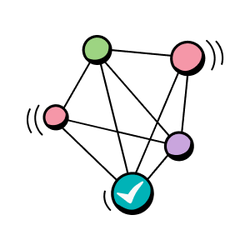
How Beca uses effectiveness surveys to fuel employee development

You want your employees to stick around and be committed to your organization. And while commitment might seem like a straightforward concept, it’s a little more complex than simply feeling dedicated to something.
It’s easier to understand commitment when you break it down into three different aspects:
- Affective commitment: When employees feel an emotional attachment and an internal desire to stay
- Continuance commitment: When employees stay because the cost of leaving feels too great
- Normative commitment: When employees stay because of social norms and what’s happening around them
Both continuance commitment and normative commitment have been a struggle for organizations, especially lately. The cost of living crisis and inflationary pressures inspire many employees to seek higher compensation – often outside their current organization. And in turn, that impacts normative commitment. When people around them are leaving, employees start thinking about following suit.
Where organizations can really make an impact is with affective commitment, which is established through solidifying a sense of belonging, growth and development, purpose, and progression.
Seem like a lofty task? It can be. But effectiveness surveys can help. In a recent webinar, Gavin Morse, Senior People Scientist here at Culture Amp, and Katrina McKay, Senior Organizational Development Consultant at Beca, talked about how these surveys allow you to reinforce a culture of feedback, identify areas of improvement, and ultimately fuel affective commitment.
What exactly is effectiveness?
“Effectiveness at its core is the opportunity to create a feedback process that ultimately enables people to learn and grow as part of their practice within the work environment,” Gavin explains.
In order for people to improve, they need to understand where to focus. What strengths do they bring to the table? What improvement areas could they work on?
The best way to get that clarity is through feedback, and that’s what Culture Amp supports with a type of employee survey known as an effectiveness survey. There are surveys to measure:
Individual effectiveness
- Leadership effectiveness
- Manager effectiveness
- Team effectiveness
All are important. But for the sake of simplicity, let’s take a closer look specifically at team effectiveness.
Team effectiveness surveys: Understanding what makes teams tick
The team effectiveness survey is “a process that uses inward feedback to help teams understand how their productivity, cohesion, and alignment are working to drive overall success for their team outcomes,” Gavin shares.
These surveys allow the team to better understand how they can improve their work together and where they want to immediately take action.
Katrina and the Beca staff have found them valuable. “I think, a lot of the time, when we are looking at a team and maybe what we need to shift in that team, we know in our gut what we need to work on. But having that quantitative data can really support the case to take action, and it gives us permission to have those important conversations,” she shares.
In addition to quantifying their own observations and perceptions, Katrina notes that these surveys have given teams another major advantage: common language. “It can be really hard to articulate the areas you want to work on, and having that shared language can also provide a valuable opportunity to create shared objectives for the team,” she adds.
When is the right time to run a team effectiveness survey?
Much like with anything else, team effectiveness surveys are all about timing. To determine when to run this sort of survey, it’s helpful to consider Tuckman’s developmental sequence for teams, which outlines four stages every team goes through:
- Forming: When members of the group first come together
- Storming: When members of the group experience healthy conflict and test boundaries
- Norming: When members of the group begin to mesh and develop their own rhythms
- Performing: When members of the group work together to achieve better outcomes
Katrina has found that team effectiveness surveys work best when a team is in the norming stage and wants to elevate itself to the performing stage. She notes that Beca generally avoids doing an effectiveness survey during the storming stage.
“If you conduct that survey within that period during storming, you’re surfacing a lot of things that are actually going to naturally resolve on their own,” Gavin echoes.
Some organizations are eager to run the survey right at the beginning of the team’s work together – particularly if they need the team to deliver on their mission right away. While you can do that, Gavin warns that it might require organizations to change the way they present the survey or amend some questions.
“In an ideal scenario, you’re going to get closer to that norming phase, especially if that team’s going to be together for a while,” he says.
How the team effectiveness survey is supported by science
Tuckman’s model lays the foundation for the team effectiveness survey – but it’s not the only research and literature that the survey is built on. It uses two other reliable models to measure both team effectiveness and dysfunction: Google’s Project Aristotle and Lencioni’s Five Dysfunctions of a Team.
These models look at varied and important aspects of teams – psychological safety, accountability, commitment, meaning, dependability, and more – to outline what ultimately makes them successful and unsuccessful.
Katrina says this research-backed approach to surveys has been particularly impactful at Beca, which she says has a workforce of highly educated people. “Many of them are engineers and they really value and appreciate knowing the aspects and what goes into the team effectiveness survey,” she says, noting that they cover the research when debriefing the survey. “I think it gives the survey strong credibility,” she adds.
And by covering all of this strong and sound research, Beca also gets to develop the capabilities and knowledge of its leaders and workforce. “The team is not only participating in the survey, but they’re also growing their knowledge and capability around teams as well,” Katrina shares.

Unlock the power of expertly designed surveys
Tips for running (and understanding) your own team effectiveness surveys
Team effectiveness surveys are a powerful way to understand where your team is excelling and where you can improve. Before rolling one out for your own team, here are a few more tips to keep in mind.
1. Determine if an effectiveness survey is the right move
Effectiveness surveys are about developing teams and employees by identifying improvement areas. That’s different from using them for true performance evaluation.
Ensure that the surveys are being used specifically for development and not as a cleverly disguised way to measure employees. “It’s so important for the integrity of the surveys that they are used for development purposes and not for the performance process,” Katrina adds.
2. Identify your outcomes
Gavin recommends that you identify an outcome measure prior to running the survey. Ask yourself: What are the five or so questions that define positive outcomes for the team?
Culture Amp’s driver analysis can help you understand how your team’s experiences impact the outcomes. “That means when it comes time to take action, we're not stuck with trying to fix 20 different items, but instead are taking the lens of ‘What is going to get us impact here?’” says Gavin.
3. Focus on strengths too
“Generally we have a tendency to want to focus on opportunities, but I think being curious with the team and getting them to think about – and, more importantly, articulate – why a particular area might be a strength for them is really important,” Katrina explains.
Of course, finding your improvement areas is a crucial part of the process. But when debriefing your survey results, don’t forget to give your team a chance to recognize and celebrate where they already excel too.
4. Give results time to breathe
People process survey results differently. Some might want to jump right into action, while others need time to reflect.
At Beca, Katrina likes to leave a gap between when the results are shared with the team and when they regroup to discuss those findings and determine action items. She believes that gives everybody a chance to digest those results and come to the conversation prepared and with the right mindset.
5. Recognize small changes
One team at Beca ran their first effectiveness survey in mid-2020 and did a second survey recently. “What was really interesting for them is that it was the really small, incremental changes that they made that they saw the impact on in their second survey results,” Katrina shares, noting that tweaking something as simple as how they ran their team meetings yielded impressive results.
Don’t underestimate the power of smaller tweaks and refinements. A change doesn’t need to be big in order to have a big impact.
6. Pick your focus areas
Katrina says teams at Beca are also skilled at focusing on one improvement area at a time and holding each other accountable when working to change those.
If you absolutely do need to focus on two things at once, she recommends choosing one strength and one opportunity. “What’s your secret sauce? What’s that thing that’s making you a really strong, powerful team, and what’s an opportunity to strengthen the team?” she asks. “I always say balance it between that strength and that opportunity.”
Effective teams translate to engaged employees
Organizations are eager to achieve higher productivity, better employee wellbeing, and higher employee retention. There’s one common thread between all of them: effectiveness.
“What I love about employee effectiveness is that it has meaningful impacts across all of those elements,” Gavin concludes.
So, as organizations aim to be more efficient and keep their best employees around, perhaps it’s time to stop asking, “How can we retain our top talent?” and rather, “How can we help our talent be most effective?” Get that part right, and the benefits will inevitably follow.





